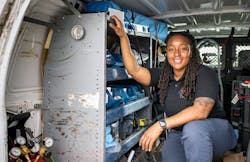Ferguson Leads HVAC Pros through the A2L Refrigerant Transition
November 12, 2024 — As the HVAC industry undergoes one of its most significant transitions — the move to A2L refrigerants — professionals must navigate a complex regulatory landscape. By Jan. 1, 2025, pros should be ready to balance compliance demands with maintaining operational efficiency.
Industry expert Trey Long, National Project Manager of Regulatory for Ferguson HVAC, based in Newport News, Va., offers practical guidance on how HVAC professionals can approach this shift confidently. With 20 years in the field, he emphasizes leveraging this transition, making it a pathway to long-term growth and innovation rather than a mere regulatory hurdle.
A proper strategy can position HVAC contractors and technicians for success in an environmentally conscious market.
Navigating a Safer, Greener Future
“A2L refrigerants mark a pivotal moment for both the industry and the environment,” says Long. “Efficiency, sustainability and safety must work together, and our responsibility is to help professionals navigate that balance.”
As systems evolve to use lower-GWP refrigerants, Ferguson provides more than equipment. The real benefit of A2L refrigerants goes beyond meeting regulations. They offer a chance to improve energy efficiency, decrease emissions and boost overall system performance. Proper guidance and information can ignite innovation rather than seeming like a mere formality.
Tool Upgrades without an Overhaul
There’s a common concern that switching to A2L refrigerants will demand purchasing new tools. However, most are already compatible and need only minor adjustments or upgrades.
“Contractors and technicians are right to be mindful of costs. But many times, these changes are less daunting than they appear. It’s a matter of a few affordable and manageable tweaks, rather than a major revamp,” says Long.
By addressing these concerns with practical solutions, pros can focus on improving efficiency without unnecessary disruptions or costly setbacks. This shift allows technicians to adapt to new regulations with ease, keeping their operations steady while evolving with the industry.
The switch to A2L refrigerants has raised concerns, especially around flammability and certifications. While these worries make sense, they often hide the real facts. The truth is that these refrigerants have been used safely and effectively in many industries. Instead of getting caught up in misunderstandings, the focus should be on giving clear, honest information.
“A2L refrigerants have a long history of reliable use in cars and appliances,” says Long. “The key priority now is to furnish technicians with the facts to advance with certainty.”
The industry can reveal the real opportunities this transition offers by steering the conversation toward the facts and data.
Beyond Compliance: Shaping the Future of HVAC
Complying is essential, as a shift to A2L refrigerants signals something much larger. HVAC professionals now have the chance to influence the industry’s future by making decisions that fulfill compliance and drive innovation and sustainability.
“This transition represents a fundamental shift in how we think about energy use and environmental impact,” says Long. “It’s not just about ticking regulatory boxes — it’s a chance for the HVAC industry to redefine its role in the global push for sustainability.”
By seeing this change as an opportunity to reshape practices, professionals can lead the industry toward a future built on resilience, efficiency and innovation.
Ferguson operates 1500 distribution centers in the United States and 200 in Canada.
Article provided by Ferguson.


